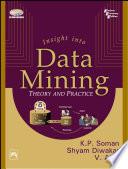
Data Mining: Know It All
This book brings all of the elements of data mining together in a single volume, saving the reader the time and expense of making multiple purchases. It consolidates both introductory and advanced topics, thereby covering the gamut of data mining and machine learning tactics ? from data integration and pre-processing, to fundamental algorithms, to optimization techniques and web mining methodology. The proposed book expertly combines the finest data mining material from the Morgan Kaufmann portfolio. Individual chapters are derived from a select group of MK books authored by the best and brightest in the field. These chapters are combined into one comprehensive volume in a way that allows it to be used as a reference work for those interested in new and developing aspects of data mining. This book represents a quick and efficient way to unite valuable content from leading data mining experts, thereby creating a definitive, one-stop-shopping opportunity for customers to receive the information they would otherwise need to round up from separate sources. Chapters contributed by various recognized experts in the field let the reader remain up to date and fully informed from multiple viewpoints. Presents multiple methods of analysis and algorithmic problem-solving techniques, enhancing the reader’s technical expertise and ability to implement practical solutions. Coverage of both theory and practice brings all of the elements of data mining together in a single volume, saving the reader the time and expense of making multiple purchases.
- ISBN 13 : 9780080877884
- ISBN 10 : 0080877885
- Judul : Data Mining: Know It All
- Pengarang : Soumen Chakrabarti, Earl Cox, Eibe Frank, Ralf Hartmut Güting, Jiawei Han, Xia Jiang, Micheline Kamber, Sam S. Lightstone, Thomas P. Nadeau, Richard E. Neapolitan, Dorian Pyle, Mamdouh Refaat, Markus Schneider, Toby J. Teorey, Ian H. Witten,
- Kategori : Computers
- Penerbit : Morgan Kaufmann
- Bahasa : en
- Tahun : 2008
- Halaman : 480
- Halaman : 480
- Google Book : https://play.google.com/store/books/details?id=WRqZ0QsdxKkC&source=gbs_api
-
Ketersediaan :
... and experience to others. Life and death. From Europe to the antipodes. Family
and business. Machine learning is a burgeoning new technology for mining
knowledge from data, a technology that a lot of people are starting to take
seriously.









